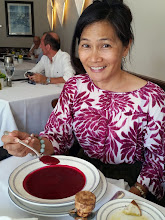Along with the the superbly criminal pun that this restaurant inspires, Mottainai is yet another foodie find, courtesy of my friend Ally. When she told me to meet her at the ramen place in Pacific Square, I was afraid that the landmark Fukagawa had closed and been replaced by a new upstart ramen shop. Happily, I was wrong.
Great noodle places are like speakeasies, with hidden entrances like the one at Otafuku on Western Avenue. After a few sweeps of the shopping center and another phone call, I realized that the place with the blue curtain with the endless knot on it was Mottainai. That's what happens when you don't know how to read Japanese.
Behind the curtain: Mottainai awaits with bowls of flavorful ramen.
The mysterious blue curtain is deceptive. Stainless steel walls give the restaurant a modern cleanliness while pine tables make it cozy. The motto painted on a cornice declares Mottainai's environmentally conscious philosophy: "Recycle + Reuse + Reduce + Respect." Loosely translated, the word "mottainai" is a lamentation of waste. It makes for an ironic counterpoint to the very act of making soup, which usually involves distilling the essence of food from scraps and parts that are normally thrown away.
In the spirit of "mottainai," they recycled the cover art from a No Doubt album for this decor.
While "Sapporo Miso Lover" might sound like the title of either a Gwen Stefani song or her latest clothing line, it is the trademark item on Mottainai's menu. The soup is a specialty of the Sapporo, which is the capital of Hokkaido, Japan. Its preparation involves flaming a mixture of miso and lard in a blazing wok. I watched entranced as one of the chefs, Hiro Igarashi, did just that behind a glass panel at the counter.
It all happened so fast. Artsy shot that exposed after the flames died down. With extra bean sprouts.
I added extra toppings of fresh spinach and an egg. I also had to have the "red bomb," a ping-pong ball of chili paste that added a nice, but not obliterating heat to the soup. Mottainai also offers another "bomb" of garlic and pork fat if you want your broth really porky. But my Sapporo already had plenty of porcine goodness, coupled with an unusual smoky flavor from the toasted miso.
Bombs away: A paste of red chilies complements the toasted miso and pork-rich broth of the Sapporo Miso Lover.
Chef Hiro offered me tastes of all the different broths they serve at Mottainai, if I had room for it after my huge bowl of soup. Sadly, I had to decline until next time. My tastebuds were too busy celebrating - and the rest of me was too full - to appreciate the savory subtleties of a "flight" of different soups.
Each of the ramen offerings were named after their region of origin: Tokyo, Yokohama, and Gardena. Yes, Gardena. For those of us who grew up in the South Bay, the city was our first introduction to Japanese food and culture. For those of us who grew up in the South Bay in the 1970s, Gardena was our first introduction to any Asian food and culture. So it deserves having a ramen named after it.
Ironically, Nissin Foods, makers of the ubiquituous Top Ramen, Cup of Noodles, and other products that have introduced mainstream palates to the joys of ramen is also located in Gardena.
I'm not knocking the stuff - Top Ramen has gotten more Americans through college than the Pell Grant. But you really haven't had ramen until you've sat down in front of a steaming bowl in one of any number of amazing hole-in-the-wall noodle shops between Crenshaw and Vermont. And you haven't really explored the surprising potential in a ball of pork fat until you've been to Mottainai.
Lemon yogurt poppy seed muffins
6 days ago













